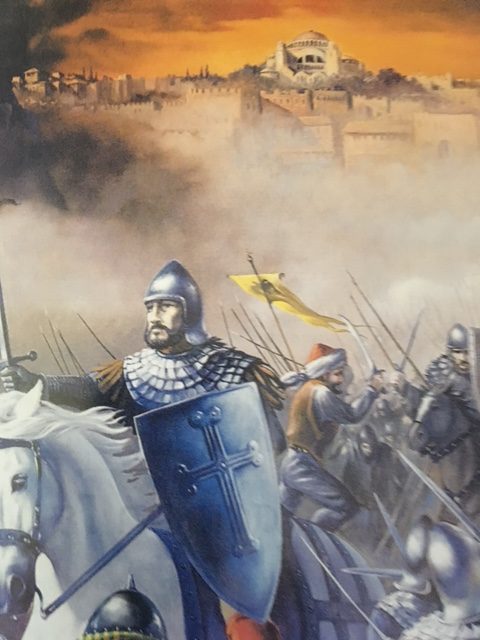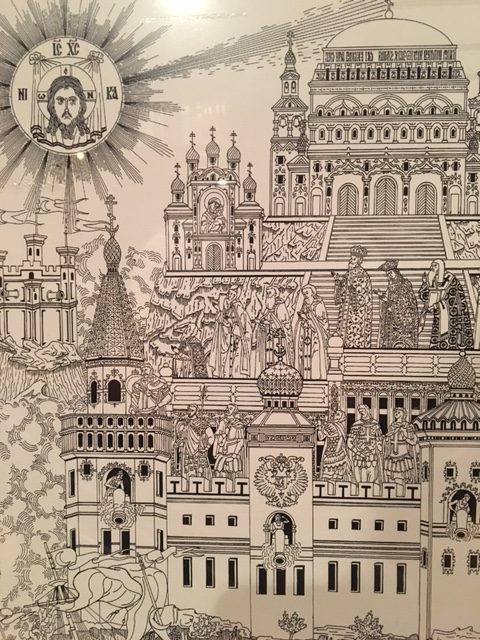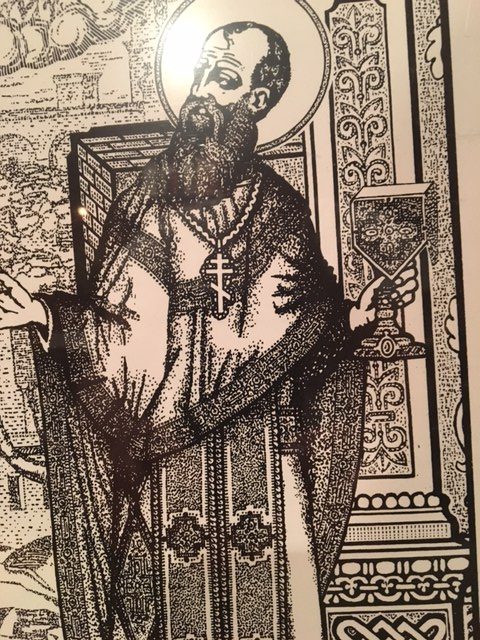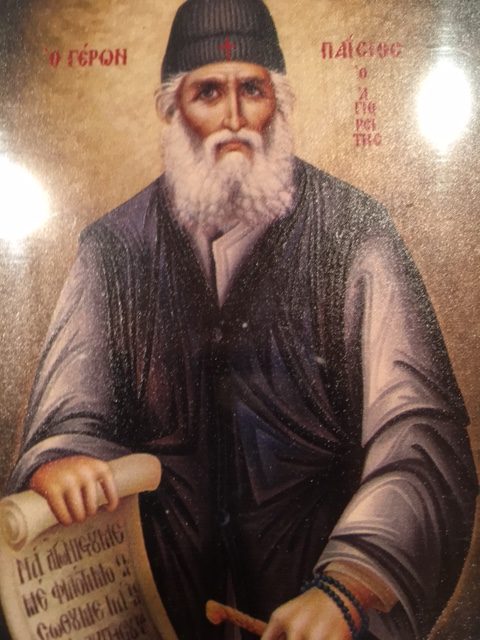The apogee of modern Greece from a nationalist perspective occurred from 1821 when the Greek war of independence began until 1923 when the Treaty of Lausanne formally gave to Turkey the lands of Asia Minor, Constantinople, Eastern Thrace, and the islands of Imbros and Tenedos. The Treaty of Lausanne whitewashed the genocide of Greek, Armenian, and Assyrian Christians and should have served as a lesson for Greeks. Greeks unfortunately have failed to learn the lessons of history.
In 2020, Turkey challenges the sovereignty of Athens over the Greek islands. Article 12 of the Treaty of Lausanne states regarding the sovereignty of the Aegean islands, “regarding the sovereignty of Greece over the islands of the Eastern Meditteranean, other than the islands of Imbros, Tenedos, and Rabbit islands, particularly the islands of Lemnos, Samothrace, Mytilene, Chios, Samos, and Nikaria, is confirmed, subject to the provisions of the present treaty respecting the islands placed under the sovereignty of Italy which form the subject of Article 15.” In Article 15 of the same Treaty it is written that “Turkey renounces in favor of Italy all rights and title over the following islands Stampalia, Rhodes, Calki, Scarpanto, Casos, Piscopis, Misiros, Calimnos, Leros, Patmos, Lipsos, Simi, and Cos which are now occupied by Italy, and the islets dependent thereon, and also the island of Castellorizo.”
The “Treaty of Peace with Italy” signed in 1947 declares the following, “Italy hereby cedes to Greece in full sovereignty the Dodecanese Islands indicated hereafter namely Stampalia, Rhodes, Calki, Scarpanto, Casos, Piscopis, Misiros, Calimnos, Leros, Patmos, Lipsos, Simi, Cos, and Castellorizo as well as the adjacent islets.”
The predatory nature of the Turkish Republic which was born through genocide can be seen by the demands of President Erdogan to revise the Treaty of Lausanne. Ankara has now put forward claims over the Greek islands despite the signing of the above mentioned treaties in 1923 and 1947. Turkey also does not care that these islands are historically Hellenic and that they are now and have always been populated by ethnic Greeks.
Greece’s problems with Turkey are compounded by the fact that Athens has never formulated a specific goal or agenda in terms of what it wants to achieve. The cancer that has eaten away at the Hellenic Republic over the decades is that of internationalism. The specific form of internationalism that is referred to here is that of blind devotion to the west. For example, Greece has shown an absolute pathetic loyalty to the North Atlantic Treaty Organization (NATO) despite the fact that the latter has done nothing for Greece or Cyprus.
NATO in fact can be blamed for the destruction of the Greek Orthodox communities in Constantinople, Imbros, and Tenedos. NATO can also be blamed for the Turkish invasion and occupation of Cyprus. When the Turkish government of Prime Minister Adnan Menderes organized the infamous pogroms against the Greek community in 1955, there was not a protest from any member of NATO or the organization itself. In fact, Greek officers serving NATO in Smyrna at the time were assaulted and none of their colleagues in NATO protested.
Turkey as a member of NATO invaded the Republic of Cyprus in 1974 which was, and remains non aligned. Turkey’s war crimes in Cyprus and the practice of ethnic cleansing against Greek Cypriots has never been opposed by NATO. Even now at this late date as Turkey threatens the islands of Greece in complete defiance of the above mentioned Treaties NATO refuses to express support for Greece’s territorial integrity.
The submissive stance of virtually all Greek governments (there are occasional exceptions) to western dictates has not doused the fire. The United States, NATO, and the European Union expect Greek foreign policy to conform with their interests. Greek submission to these expectations have been utterly destructive and has contributed to the present circumstances of helplessness that Greece finds itself in.
The worst Government that Greece has had not only in the post dictatorship era (1967-1974), but arguably since the formation of the modern Greek state has been that of Prime Minister Costas Simitis (1996-2004). Under Simitis, Greek sovereignty was effectively eradicated as Athens delivered Kurdish leader Abdullah Ocalan to the Turks. Furthermore. Simitis and his Foreign Minister George Papandreou negotiated the Annan Plan for Cyprus which was rejected by seventy six percent of Cypriots and which would have denied Greek Cypriot refugees the right of return and freedom of movement.
In addition, Simitis attacked the Orthodox Church of Greece and its leader Archbishop Christodoulos who rejected not only the anti Church policies dictated by Europe but the violation of Greek sovereignty by the the European Union. Greece has always had an interest in aligning with anti Turkish forces. Greece had an interest in supporting the Kurds in their fight against Turkey, so it was an outrage when Athens colluded to betray the Kurds in 1999.
Likewise, the Simitis government permitted NATO to use Greek territory to take off and bomb Serbia. Serbia is Greece’s closest ally in the Balkans and the two countries defeated the Turks and the Bulgarians in the Balkan wars. Greece did not have an interest in the destruction of Serbia but as always Athens did what Washington dictated.
It is the year 2020, Turkey for now has stable and cordial relations with both Washington and Moscow. This is despite the fact that Turkey since 1994 has gradually evolved into an Islamic state under the leadership of President Erdogan. Turkey has colluded with the genocidal ISIS by purchasing oil from the “caliphate” when it was at the height of its power and in occupation of one third of both Iraq and Syria.
Volunteers from the west who sought to join ISIS travelled through Turkey to make their way to join the Jihad. In 2015, Turkey shot down a Russian plane over Syria, and the Russian Ambassador in Turkey was assassinated by a Turkish Jihadist. Inexplicably, Turkey remains in good standing with Washington and Moscow.
The Trump administration is the first administration to actually reject Turkish demands. It has refused to extradite the exiled Fetullah Gulen to Turkey, and when Erdogan demanded it, the Trump administration refused to cut off the Syrian Kurds when they were fighting ISIS. Since the downfall of ISIS, the Trump administration betrayed the Kurds and has reconciled with Turkey.
International relations are immensely complicated and alliances are changing frequently. Turkey’s present relations with Moscow and Washington may not remain friendly over the long term. Turkish President Erdogan has demonstrated that he is a psychopath and is even less restrained than his Kemalist predecessors whom he dislodged once and for all after the coup of 2016.
In 2010, a group of spoiled and immature left wing activists left on a flotilla from the Turkish occupied territories of Cyprus and proceeded to Gaza to confront the Israelis. The situation in Gaza is beyond the scope of this analysis but Turkey instigated a confrontation with Israel that could have led to war. The Israelis backed off.
In 2015, Turkey shot down the aforementioned Russian plane over Syria. Turkey is a member of NATO and the latter has a commitment to come to Ankara’s defense. Erdogan ordered the shooting of the Russian plane without consideration for the possibility that a third world war could have broken out. The Russians, like the Israelis, chose to deescalate.
The Trump administration having committed to the destruction of ISIS armed the Syrian Kurds. Turkey actively threatened to invade the Kurdish areas of Syria and was willing to risk a military confrontation with American forces. The Trump administration chose deescalation. Deescalation gradually evolved into appeasement of Turkey.
Greece has badly mishandled relations with Russia. Most of the blame here goes to former Prime Minister Alexis Tsipras. For some time, Moscow appeared interested in ties with Greece. After the shooting down of the Russian plane by Turkey, Greece had a chance to negotiate with Russia and to raise the issues of Cyprus and territorial rights in the Aegean.
Like the Simitis government that surrendered Abdullah Ocalan and signed the Annan Plan for Cyprus, the Tsipras government followed the command of Washington and rejected the possibility of negotiating with Russia. One could spend much time reflecting that Greek sovereignty and independence are non existent but that would take too long. One must only remember how Washington brought down the Karamanlis government in 2009 because that administration was planning to build an oil pipeline with Russia.
In 2018, the Greek Foreign Ministry stupidly accused the Russians of meddling in Greek internal affairs. The history of modern Greece has no shortage of western meddling in Greek affairs, and if there was time we could go back to the Crusades and the invasions of Constantinople, Cyprus, and other Greek lands. In 2018, Russian officials anxious to keep Skopje (FYROM) out of NATO lobbied various Greek officials for assistance.
FYROM which was the acronym of the country now called “northern macedonia” provoked Greece by stealing the name and cultural and historical heritage of Macedonia. Macedonia is a northern Greek province and is the birthplace of Alexander the Great and the region that produced the Macedonian dynasty that ruled the Byzantine Empire for two hundred years. The Russians aware of Greece’s dispute with FYROM sought to work with Greece to achieve their own goals.
Prime Minister Tsipras taking orders from Washington expelled Russian diplomats and subsequently signed an agreement with FYROM that gave it the use of the name “Macedonia”. It gets even more depraved after this. Athens obeying the dictates of Washington blocked a Russian Bishop and priests from making a pilgrimage to the Holy Mountain of Athos.
Washington has now actively intervened in the affairs of the Greek Orthodox Churches. There are two posts on this blog that offer a perspective on what has taken place. They can be found here https://thedoubleheadedeagle.blog/the betrayal-of-the-spiritual-heritage-of-constantinople/2020/faith/ and here https:thedoubleheadedeagle.blog/therecent-past-of-greek-orthodoxy-and-the-crisis-of-today/2020/political/
Greece today has no vision beyond being “western”. Greeks need to define what their goals and aspirations are. They need to rediscover the memory of their ancestors who fought for the liberation of Greek lands. Membership in NATO has been destructive for Greece, and membership in the European Union has been disastrous as well.
Greek diplomacy is a failure. However, there is still the possibility of preventing catastrophe. Erdogan makes many demands of other nations and eventually one or all of them may come to the realization that the Turkish tyrant cannot be reasoned with. Erdogan cannot be removed from within Turkey. Somewhere down the line, he may have to be removed by a foreign army.
There is still some hope for Greece. Erdogan may have done all enemies of Turkey a favor by destroying the vestiges of Kemalism. Turkey was in many ways indestructible as long as the ideas of Mustafa Kemal maintained their influence over the Turkish military.
One of the aspects of Kemalism that made Turkey so influential over western societies was the narcissism of westerners themselves. Kemal abolished the Fez, the headscarf, and the veil. He forced men to shave and he forced men and women alike to dress like Europeans and Americans. It was hard for westerners not to be impressed with Kemal’s efforts to clone his people after them, notwithstanding his responsibility for genocide.
Furthermore, Turkey’s borders near Russia (and its successor the Soviet Union), central asia, the balkans, and the middle east attracted America and Europe. Economic considerations likewise played a role. Turkey was also one of the very few Muslim countries that recognized Israel.
As an officially secular country, the Turkish military was able to influence their civilian leaders into a friendship and subsequent military alliance with Israel. In 1996, Turkey and Israel signed an important military agreement and then Chief of Staff of the Turkish Army General Ismail Hakki Karadayi was given an honorary dinner by the Israelis upon the signing of the pact.
That alliance led to Israeli participation in the capture of the leader of the Kurds and Israeli spies were sent to Cyprus to gain information on the S 300 anti aircraft missiles that were then planned to be installed by Nicosia. Erdogan has destroyed what was once an invaluable alliance for Turkey. He has repeatedly expressed his contempt for Israel and has accused Tel Aviv of genocide.
The secular Turkey that made such an impression on the west is gone. Erdogan’s hostility has destroyed the alliance with Israel that the Kemalists had worked very hard to establish. Erdogan has nearly started wars with Israel, Russia, and the United States.
The biggest problem for Greece is that the Greek elites think in terms of being Europeans and westerners, rather than as Greeks. A future post will discuss this particular matter. Greece must recapture the mindset of past heroes ranging from Theodore Kolokotronis to Eleutherios Venizelos who were Greek nationalists.
In conclusion, the priorities of the Greek government must be the liberation of Cyprus and the reversal of Turkish colonization, the defense of all Greek islands and other territory, and the restoration of Greek national sovereignty and the removal of foreign intervention in the formulation of Greek foreign and domestic policies. Greece and Cyprus both face an existential crisis.
Foreign policy must be based on this reality. Greek foreign policy must undergo a policy of radical Hellenization in order to meet the growing Turkish threat. It is a tremendous mistake for anyone to believe that Greek foreign policy is being conducted solely and exclusively for the benefit of the Hellenic world.
End of Part One






